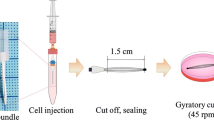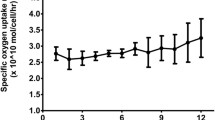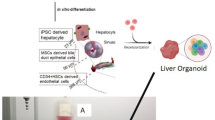Abstract
Liver failure is a major cause of mortality. A bioartificial liver (BAL) employing isolated hepatocytes can potentially provide temporary support for liver failure patients. We have developed a bioartificial liver by entrapping hepatocytes in collagen loaded in the luminal side of a hollow fiber bioreactor. In the first phase of development, liver-specific metabolic activities of biosynthesis, biotransformation and conjugation were demonstrated. Subsequently anhepatic rabbits were used to show that rat hepatocytes continued to function after the BAL was linked to the test animal. For scale-up studies, a canine liver failure model was developed using D-galactosamine overdose. In order to secure a sufficient number of hepatocytes for large animal treatment, a collagenase perfusion protocol was established for harvesting porcine hepatocytes at high yield and viability. An instrumented bioreactor system, which included dissolved oxygen measurement, pH control, flow rate control, an oxygenator and two hollow fiber bioreactors in series, was used for these studies. An improved survival of dogs treated with the BAL was shown over the controls. In anticipated clinical applications, it is desirable to have the liver-specific activities in the BAL as high as possible. To that end, the possibility of employing hepatocyte spheroids was explored. These self-assembled spheroids formed from monolayer culture exhibited higher liver-specific functions and remained viable longer than hepatocytes in a monolayer. To ease the surface requirement for large-scale preparation of hepatocyte spheroids, we succeeded in inducing spheroid formation in stirred tank bioreactors for both rat and porcine hepatocytes. These spheroids formed in stirred tanks were shown to be morphologically and functionally indistinguishable from those formed from a monolayer. Collagen entrapment of these spheroids resulted in sustaining their liver-specific functions at higher levels even longer than those of spheroids maintained in suspension. For use in the BAL, a mixture of spheroids and dispersed hepatocytes was used to ensure a proper degree of collagen gel contraction. This mixture of spheroids and dispersed cells entrapped in the BAL was shown to sustain the high level of liver-specific functions. The possibility of employing such a BAL for improved clinical performance warrants further investigations.
Similar content being viewed by others
References
Abouna GM, Fischer LM, Porter KA and Andres (1973) Experience in the treatment of heptic failure by intermittent liver hemoperfursions. Surg Gynecol Obset 137, 741–752.
Akaike T, Tobe S, Kobayashi A, Goto M and Kobayashi K (1993) Design of hepatocyte-specific extracellular matrices for hybrid artificial liver. Gastroenterol Jpn 4, 45–52.
Busuttil TW, Colonna JO, Hiat JR, Brems JJ, el Khoury G, Goldstein LI, Quinones-Baldrich WJ, Abdul-Rasool IH and Ramming KP (1987) The first 100 liver transplants at UCLA. Ann Surg 206, 387–402.
Chang TMS (1972) Haemoperfusions over a microencapsulated adsorbent in a patient with hepatic coma. Lancet 2, 1371–1372.
Cima LG, Langer R and Vacanti JP (1991) Polymers for organ and tissue culture. J Bioact Compat Polymers 6, 232–240.
Dich J, Vind C and Grunnet N (1988) Long-term culture of hepatocytes: Effect of hormones on enzyme activities and metabolic capacity. Hepatology 8, 39–45.
Dunn J, Yarmush M, Koebe H and Tompkins R (1989) Hepatocyte function and extracellular matrix geometry: long-term culture in a sandwich configuration. FASEB J 3, 174–177.
Dunn J, Tompkins R and Yarmush M (1992) Hepatocytes in collagen sandwich: evidence for transcriptional and translational regulation. J Cell Biol 116, 1043–1053.
Eiseman B, Liem DS and Raffucci F (1965) Heterologous liver perfusion in treatment of hepatic failure. Ann Surg 162, 329–345.
Eiseman B, Norton L and Kralios NC (1976) Hepatocyte perfusion within a centrifuge. Surg Gynecol Obstet 142, 21–28.
Fischer M, Botterman P, Sommoggy SPS and Ernhardt W (1981) 'Functional capacity of extracorporeal baboon liver perfusion', in Brunner G and Schmidt FW, Artificial Liver Support, Springer-Verlag Publications, Berlin, 280–285.
Galletti PM (1987) Thrombosin in extracorporeal devices. Ann NY Acad Sci 516, 679–682.
Hagar JC, Carman R, Porter LE, Stoller R, Leduc EH, Galletti PM and Calabresi P (1983) Neonatal hepatocyte culture on artificial capillaries: a model for drug metabolism and the artificial liver. ASAIO J 6, 26–35.
Hori M, Neto AC, Austen WG and McDermott WV (1967) Isolated in vivo hepatorenal perfusion in the dog: Circulating and functional response of the kidney to hepatic anoxia. J Surg Res 7, 413–417.
Kiley JE, Welch HF, Pender JC and Welch CS (1956) Removal of blood ammonia by hemodialysis. Proc Soc Exptl Biol and Med 91, 489–490.
Kimoto S (1959) The artificial liver, experiments and clinical application, Transactions — American Society of Artificial Internal Organs 5, 102–112.
Koide N, Shinji T, Tanabe T, Asano K, Kawaguchi M, Sakaguchi K, Koide Y, Mori M and Tsuji T (1989) Continued high albumin production by multicellular spheroids of adult rat hepatocytes formed in the presence of liver-derived proteoglycans. Biochem Biophys Res Commun 161, 385–391.
Koide N, Sakaguchi K, Koide Y, Asano K, Kawaguchi M, Matsushima H, Takenami T, Shinji T, Mori M and Tsuji T (1990) Formation of multicellular spheroids composed of adult rat hepatocytes in dishes with positively charged surfaces and under other nonadherent environments. Exp Cell Res 186, 227–35.
Lanford RE, Carey KD, Estlack LE, Smith GC and Hay RV (1989) Analysis of plasma protein and lipoprotein synthesis in long-term primary cultures of baboon hepatocytes maintained in serum-free medium. In Vitro Cell and Develop Biol 25, 174–182.
Lazar A, Madhusudan PV, WU Fj, Chi CM, Cerra FB and Hu W-S (1995) Formation of porcine hepatocyte spheroids for use in a bioartificial liver. Cell Transplant 4, 259–268.
Lazar A, Mann HJ, Remmel RP, Shatford RA, Cerra FB, Hu W-S (1995) Extended liver-specific functions of porcine hepatocyte spheroids entrapped in collagen gel. In Vitro Cell Develop 31, 340–346.
Lie TS (1981), 'Treatment of acute hepatic failure by extracorporeal hemoperfusion over human and baboon liver', in Brunner G and Schmidt FW, Artificial Liver Support, Springer-Verlag Publications, Berlin, 274–279.
Matsumara K (1973) Method and device for purifying blood, U.S. Patent No. 3734851, U.S. Patent Office, Washington, D.C.
Matsumara KN, Guevara GR, Huston H, Hamilton WL, Rikimaru M, Yamasaki G and Matsumara MS (1987) Hybrid bioartificial liver in hepatic failure: preliminary clinical report. Surgery 101, 99–103.
Mikos AG, Bao Y, Cima LG, Ingber DE, Vacanti JP and Langer R (1993) Preparation of poly(glycolic acid) bonded fiber structures for cell attachment and transplantation. J Biomed Mat Res 27, 183–189.
National Center for Health Statistics (1991) Briths, Marriages, Divorces and Deaths for 1990, Monthly Vital Statistics Report, 39, 1–14.
Neuzil D, Rozga J, Moscioni A, Ro M, Hakim R and Demetriou A (1991) Use of a xenogeneic liver support system to treat a patient with acute liver failure. Hepatology 14, 246A.
Norman JC, Saravis CA,, Brown ME and McDermott WVJ (1966) Immunological observations in clinical heterologous (xenogeneic) liver perfusions. Surgery 60, 179–190.
Nose Y, Mikami J, Kasai K, Sasaki E, Agishi T and Danjo Y (1963) An experimental artificial liver utilizing extracorporeal metabolism with sliced or granulated canine liver. Trans Am Soc Artif Intern Organs 9, 358–362.
Nyberg Sl, Shatford RA, Payne W, Hu WS, Cerra FB (1992) Hepatocyte culture systems for artificial liver supprot: implications for critical care medicine (bioartificial liver support). Crit Care Med 20, 1157–1168.
Nyberg SL, Shatford R, Peshwa MW, White JG, Cerra FB and Hu W-S (1993) Evaluation of a hepatocyte entrapment hollow fiber bioreactor: a potential bioartificial liver. Biotechnol Bioeng 41, 194–203.
Nyberg SL, Shirabe K, Peshwa M, Sielaff TD, Crotty PL, Mann HJ, remmel RP, Payne WD, Hu W-S and Cerra FB (1993) Extracorporeal application of a gel-entrapment, bioartificial liver: demonstration of drug metabolism and other biochemical functions. Cell Transplantation 2, 441–452.
Nyberg SL, Payne WD, Amiot B, Shirabe K, Remmel RP, Hu W-S and Cerra FB (1993) Demonstration of biochemical function by extracorporeal xeno-hepatocytes in an anhepatic animal model. Transplant Proc 25, 1944–1945.
Nyberg SL, Mann HJ, Hu MY, Payn WD, Cerra FB, Remmel RP and Hu W-S (1996) Extrahepatic metabolism of 4-methylumbelliferone and lidocaine in the anhepatic rabbit. Drug Metabolism and Disposition 24, 643–648.
Opolon P, Rapin JR, Huguet C, Granger A, Delorme ML, Boschat M and Sausse A (1976) Hepatic failure coma treated by poly-acrylonitrile membrane hemodialysis. Trans Am Soc Artif Intern Organs 22, 701–710.
Otto JJ, Pender JC, Cleary JH, Sensening DM and Welch DS (1958) The use of a donor liver in experimental animals with elevated blood ammonia. Surgery 43, 301–309.
Peleman RR, Gavaler JS, van Thiel DH, Esquivel C, Gordon R, Iwatsuki S and Starzl TE (1987) Orthotopic liver transplantation for acute and subacute hepatic failure in adults. Hepatology 7, 484–489.
Peshwa MV, Wu FJ, Follstad BD, Cerra FB and Hu W-S (1994) Kinetics of formation of hepatocyte spheroids. Biotechnol Prog, Accepted April 14, 1994.
Peshwa MV, Wu FJ, Sharp HL, Cerra FB and Hu W-S (1994) Mechanistics of formation and ultrastructural evaluation of hepatocyte spheroids. In Vitro Cell and Develop Biol, submitted.
Peshwa MV, Wu FJ, Follstad BD, Cerra FB and Hu W-S (1994) Kinetics of hepatocyte spheroid formation. Biotechnol Prog 10, 460–466.
Peshwa MV, Wu FJ, Sharp HL, Cerra FB and Hu W-S (1996) Mechanistics of formation and ultrastructural evaluation of hepatocyte spheroids. In Vitro Cell Develop 32, 197–203.
Schechter DC, Nealon TF and Gibbon JH (1958) A simple extracorporeal device for dreducing elevated blood ammonia levels. Surgery 44, 892–897.
Sielaff TD, Hu MY, Rao S, Groehler K, Olson D, Amiot B and Hu W-S (1995) A technique for porcine hepatocyte harvest and description of differentiated metabolic functions in static culture. Transplantation 59, 1459–63.
Sielaff TD, Hu MY, Amiot B, Rollins MD, Rao S, McGuire B, Bloomer JR, Hu W-S and Cerra FB (1995) Gel-entrapment bioartificial liver therapy in galactosamine hepatitis. J Surg Res 59, 179–184.
Sielaff TD, Hu MY, Rollins M, Bloomer JR, Amiot B, Hu W-S and Cerra FB (1995) An anesthetized model of lethal canine galactosamine fulminant hepatic failure. Hepatology 21, 796–804.
Shatford RA, Nyberg SL, Payne WD, Hu W-S and Cerra FB (1991) Hepatocyte function in a hollow fiber bioreactor: a potential bioartificial liver. J Surg Res 53, 549–557.
Shatford RA, Nyberg SL, Payne WD, Hu W-S and Cerra FB (1991) A hepatocyte bioreactor as a potential bioartificial liver: demonstration of prolonged tissue specific functions. Surgical Forum 42, 54–56.
Shimaoka S, Nakamura T and Ichihara A (1987) Stimulation of growth of primary cultured adult rat hepatocytes without growth factors by coculture with nonparenchymal liver cells. Exp Cell Res 172, 228–242.
Spray DC, Fujita M, Saez J, Choi H, Watanabe T. Hertzberg E, Rosenberg L and Reid L (1987) Proteoglycans and glycosaminoglycans induce gap junction synthesis and function in primary liver cultures. J Cell Biol 105, 541–551.
Starzl TE, Demetris Aj and van Thiel D (1989) Liver transplantation (1). New Engl J Med 321, 1092–1099.
Takahashi T, Malchesky PS and Nose Y (1991) Artificial liver. State of the art. Dig Dis Sci 36, 1327–1340.
Ton HY, Hughes RD, Silk DBA and Williams R (1979) Albumin coated Amberlite XAD-7 resin for hemoperfusion in acute liver failure. Part I: Adsorption studies. Artif Organs 3, 20–22.
Tong, JZ, De LP, Furlan V, Cresteil T, Bernard O and Alvarez F (1992) Long-term culture of adult rat hepatocyte spheroids. Exp Cell Res 200, 326–332.
Vacanti JP, Lillehei CW, Jenkins RL, Donahoe PK, Cosimi AB, Kleinman R, Grand RJ and Cho SI (1987) Liver transplantation in children: The Boston Center experience in the first 30 months. Transplant Proc 19, 3261–3266.
Vacanti JP, Morse MA, Saltzman WM, Domb AJ, Perez-Atayde A and Langer R (1988) Selective cell transplantation using bioabsorbable artificial polymers as matrices. J Pediatr Surg 23, 3–9.
Wu FJ, Peshwa MV, Cerra FB and Hu W-S (1995) Entrapment of hepatocyte spheroids in a hollow fiber bioreactor as a potential bioartificial liver. Tissue Eng 1, 29–40.
Wu FJ, Friend JR, Hsiao CC, Zilliox MJ, Ko WJ, Cerra FB and Hu W-S (1996) Efficient assembly of rat hepatocyte spheroids for tissue engineering applications. Biotechnol Bioeng 50, 404–415.
Wu FJ, Friend JR, Lazar A, Mann HJ, Remmel RP, Cerra FB and Hu WS (1996) Hollow fiber bioartificial liver utilizing collagen entrapped porcine hepatocyte spheroids. Biotechnol Bioeng 52, 34–44.
Yamamoto N, Imazato K and Matsumoto A (1989) Growth stimulation of adult rat hepatocytes in a primary culture by soluble factor(s) secreted from nonparenchymal liver cells. Cell Struct Funct 14, 217–229.
Yatzidis H (1964) A convenient hemoperfusion microapparatus over charcoal for the treatment of endogeneous and exogeneous intoxications: Its use as an effective artificial kidney. Proc Eur Dial Transplant Assoc 1, 83–87.
Author information
Authors and Affiliations
Rights and permissions
About this article
Cite this article
Hu, WS., Friend, J.R., Wu, F.J. et al. Development of a bioartificial liver employing xenogeneic hepatocytes. Cytotechnology 23, 29–38 (1997). https://doi.org/10.1023/A:1007906512616
Issue Date:
DOI: https://doi.org/10.1023/A:1007906512616




